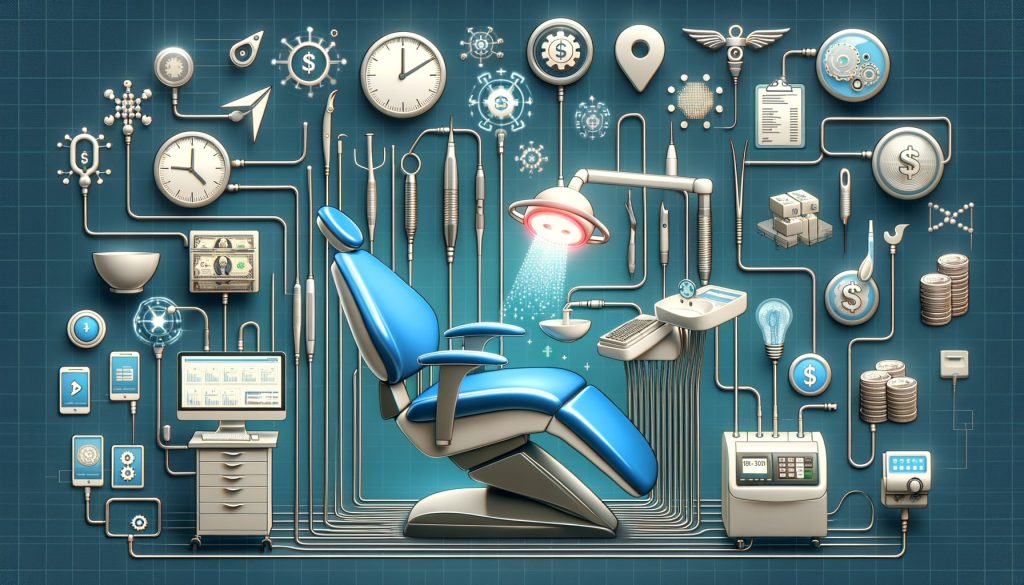By Francesca Law January 21, 2025
In today’s digital age, technology has revolutionized the way businesses operate, and the dental industry is no exception. Dental practice management software has become an essential tool for dental practices to streamline their operations, improve efficiency, and enhance patient care. One crucial aspect of dental practice management software is the integration of payment processing capabilities.
This integration allows dental practices to seamlessly handle financial transactions, improve patient experience, and ensure data security and compliance. In this comprehensive article, we will explore the impact of integrating payment processing with dental practice management software, including its benefits, how to choose the right payment processing solution, step-by-step guide to integration, common challenges and solutions, and more.
Benefits of Integrating Payment Processing with Dental Practice Management Software

1. Improved Efficiency: Integrating payment processing with dental practice management software eliminates the need for manual payment handling and reduces administrative tasks. It allows dental practices to automate payment processes, such as billing, invoicing, and payment reconciliation, saving time and effort for both the staff and patients.
2. Streamlined Financial Management: By integrating payment processing, dental practices can have a centralized system to manage their financial transactions. This integration enables real-time tracking of payments, generating financial reports, and simplifying accounting processes. It provides dental practices with a comprehensive view of their financial health, allowing them to make informed decisions and optimize their revenue cycle.
3. Enhanced Patient Experience: Integrated payment processing offers convenience and flexibility to patients. They can make payments using various methods, such as credit cards, debit cards, or mobile wallets, at their convenience. It eliminates the hassle of manual payment collection, reduces waiting time, and enhances the overall patient experience. Moreover, integrated software can send automated payment reminders and notifications, reducing the chances of missed or late payments.
4. Increased Revenue: Integrating payment processing with dental practice management software can help dental practices increase their revenue. It enables practices to offer flexible payment options, such as installment plans or recurring payments, making it easier for patients to afford dental treatments. Additionally, integrated software can provide real-time eligibility verification and insurance claim processing, ensuring accurate and timely reimbursement, thus maximizing revenue for the practice.
5. Data Security and Compliance: Payment processing integration ensures the security and compliance of sensitive patient and financial data. Reputable payment processing solutions adhere to industry standards, such as Payment Card Industry Data Security Standard (PCI DSS), to protect cardholder information. Integration with dental practice management software ensures that payment data is securely transmitted and stored, reducing the risk of data breaches and maintaining compliance with privacy regulations.
How to Choose the Right Payment Processing Solution for Your Dental Practice

Choosing the right payment processing solution for your dental practice is crucial to ensure seamless integration and maximize the benefits. Here are some factors to consider when selecting a payment processing solution:
1. Compatibility with Dental Practice Management Software: Ensure that the payment processing solution is compatible with your existing dental practice management software. Integration should be smooth and seamless, allowing for real-time data synchronization and minimizing disruptions to your workflow.
2. Payment Methods and Flexibility: Evaluate the payment methods supported by the solution. It should offer a wide range of options, including credit cards, debit cards, mobile wallets, and online payments. Additionally, consider if the solution supports recurring payments, installment plans, or split payments to cater to different patient preferences and financial situations.
3. Security and Compliance: Data security is of utmost importance when handling financial transactions. Choose a payment processing solution that is PCI DSS compliant and offers robust security measures, such as encryption and tokenization, to protect sensitive payment data. Additionally, ensure that the solution adheres to privacy regulations, such as the Health Insurance Portability and Accountability Act (HIPAA), to safeguard patient information.
4. Cost and Pricing Structure: Evaluate the cost and pricing structure of the payment processing solution. Consider factors such as transaction fees, setup fees, monthly fees, and any additional charges for value-added services. Compare different solutions to find the one that offers competitive pricing and aligns with your budget and expected transaction volume.
5. Customer Support and Service: Look for a payment processing solution that provides reliable customer support and service. Consider factors such as availability, response time, and the level of technical expertise offered. Prompt and efficient support is crucial to address any issues or concerns that may arise during integration or daily operations.
Step-by-Step Guide to Integrating Payment Processing with Dental Practice Management Software
Integrating payment processing with dental practice management software may seem like a complex process, but with the right approach, it can be seamless and efficient. Here is a step-by-step guide to help you through the integration process:
1. Assess Your Current Workflow: Before integrating payment processing, evaluate your current workflow and identify pain points or areas that can be improved. Understand your existing payment processes, including how payments are collected, recorded, and reconciled. This assessment will help you determine the specific requirements and goals for integrating payment processing.
2. Research and Select a Payment Processing Solution: Conduct thorough research to identify reputable payment processing solutions that align with your requirements. Consider factors such as compatibility, supported payment methods, security measures, and pricing. Shortlist a few solutions that meet your criteria and request demos or trials to evaluate their functionality and user-friendliness.
3. Coordinate with Your Dental Practice Management Software Provider: Contact your dental practice management software provider to discuss the integration process. They may have specific recommendations or requirements for integrating payment processing. Ensure that the payment processing solution you have chosen is compatible with your software, and coordinate with both providers to facilitate a smooth integration.
4. Set Up Merchant Account and Payment Gateway: To process payments, you will need to set up a merchant account and payment gateway with the chosen payment processing solution. Follow the provider’s instructions to complete the necessary paperwork and provide any required documentation. Once approved, you will receive the credentials and access to the payment gateway.
5. Configure Integration Settings: Work with your dental practice management software provider and the payment processing solution provider to configure the integration settings. This includes setting up the connection between the two systems, mapping data fields, and defining rules for payment processing. Ensure that the integration is tested thoroughly to verify data synchronization and functionality.
6. Train Staff and Test the Integration: Train your staff on how to use the integrated payment processing system. Provide them with comprehensive training materials and conduct hands-on sessions to familiarize them with the new workflow. Test the integration thoroughly to ensure that payments are processed accurately, data is synchronized in real-time, and any automated features, such as payment reminders, are functioning correctly.
7. Communicate with Patients: Inform your patients about the new payment options and the benefits of the integrated system. Update your website, social media platforms, and any patient communication channels to highlight the convenience and flexibility offered by the integrated payment processing. Provide clear instructions on how to make payments and address any frequently asked questions to minimize confusion or resistance from patients.
8. Monitor and Optimize: Once the integration is live, monitor the system closely to identify any issues or areas for improvement. Track payment processing metrics, such as transaction success rates, average payment time, and patient feedback. Use this data to optimize the integration, address any bottlenecks, and continuously improve the patient experience and financial management processes.
Common Challenges and Solutions in Integrating Payment Processing with Dental Practice Management Software

While integrating payment processing with dental practice management software offers numerous benefits, it can also present some challenges. Here are some common challenges and their solutions:
1. Technical Compatibility Issues: Integrating two different systems can sometimes lead to technical compatibility issues. To overcome this challenge, ensure that the payment processing solution you choose is compatible with your dental practice management software. Coordinate with both providers to address any compatibility issues and ensure a smooth integration.
2. Data Synchronization and Accuracy: Real-time data synchronization between the dental practice management software and the payment processing solution is crucial for accurate financial management. To ensure data synchronization and accuracy, thoroughly test the integration before going live. Verify that patient information, payment details, and financial reports are synchronized correctly and match across both systems.
3. Staff Training and Adoption: Introducing a new integrated payment processing system requires staff training and adoption. Provide comprehensive training to your staff on how to use the system, including payment processing, generating reports, and addressing patient queries. Encourage staff to embrace the new system by highlighting its benefits and addressing any concerns or resistance they may have.
4. Patient Education and Adoption: Educating patients about the new payment options and encouraging adoption can be a challenge. Communicate with patients through various channels, such as your website, social media platforms, and in-person interactions. Clearly explain the benefits of the integrated system, such as convenience, flexibility, and enhanced patient experience. Address any frequently asked questions and provide step-by-step instructions on how to make payments using the new system.
5. Security and Compliance: Ensuring data security and compliance is crucial when handling financial transactions and sensitive patient information. Choose a payment processing solution that is PCI DSS compliant and adheres to privacy regulations, such as HIPAA. Implement robust security measures, such as encryption and tokenization, to protect payment data. Regularly monitor and update security protocols to stay ahead of potential threats.
Enhancing Patient Experience through Integrated Payment Processing

Integrated payment processing plays a significant role in enhancing the overall patient experience at dental practices. Here are some ways in which integrated payment processing improves patient experience:
1. Convenience and Flexibility: Integrated payment processing offers patients convenience and flexibility in making payments. They can choose from various payment methods, such as credit cards, debit cards, or mobile wallets, based on their preference. Patients can make payments at their convenience, whether it is in-person, online, or through a mobile app, reducing waiting time and streamlining the payment process.
2. Automated Payment Reminders: Integrated payment processing software can send automated payment reminders to patients. This eliminates the need for manual follow-ups and reduces the chances of missed or late payments. Patients receive timely notifications about upcoming payments, making it easier for them to stay on top of their financial obligations.
3. Transparent Billing and Invoicing: Integrated payment processing provides patients with transparent billing and invoicing. They can view detailed invoices, including treatment costs, insurance coverage, and any outstanding balances, through patient portals or online platforms. This transparency builds trust and allows patients to understand their financial responsibilities, reducing confusion or disputes.
4. Seamless Insurance Claim Processing: Integrated payment processing can streamline insurance claim processing for patients. The software can verify insurance eligibility in real-time, ensuring accurate coverage information and reducing claim rejections. Patients can have a clear understanding of their insurance benefits and any out-of-pocket expenses, facilitating smoother financial planning for their dental treatments.
5. Faster Check-Out Process: Integrated payment processing simplifies the check-out process for patients. With automated payment processing, patients can quickly settle their bills without the need for manual calculations or paperwork. This reduces waiting time and enhances the overall efficiency of the dental practice, leading to a positive patient experience.
Streamlining Financial Management with Integrated Payment Processing
Integrating payment processing with dental practice management software streamlines financial management processes, offering numerous benefits to dental practices. Here are some ways in which integrated payment processing streamlines financial management:
1. Real-Time Payment Tracking: Integrated payment processing provides dental practices with real-time payment tracking. They can monitor payments as they are processed, ensuring accurate and up-to-date financial information. This real-time visibility allows practices to identify any outstanding balances, track revenue, and make informed financial decisions.
2. Automated Invoicing and Billing: Integrated payment processing automates the invoicing and billing processes. Dental practices can generate invoices automatically based on treatment codes, insurance coverage, and patient information. This eliminates the need for manual invoice generation, reducing administrative tasks and ensuring accuracy in billing.
3. Efficient Payment Reconciliation: Integrated payment processing simplifies payment reconciliation for dental practices. The software automatically matches payments received with corresponding invoices, reducing the chances of errors or discrepancies. This streamlines the reconciliation process, saves time, and ensures accurate financial records.
4. Financial Reporting and Analytics: Integrated payment processing software offers comprehensive financial reporting and analytics capabilities. Dental practices can generate reports on revenue, payment trends, outstanding balances, and other financial metrics. These reports provide valuable insights into the financial health of the practice, enabling data-driven decision-making and strategic planning.
5. Revenue Optimization: Integrated payment processing helps dental practices optimize their revenue cycle. The software can automatically verify insurance eligibility, ensuring accurate claim submissions and timely reimbursement. Practices can also offer flexible payment options, such as installment plans or recurring payments, to make dental treatments more affordable for patients. These revenue optimization strategies contribute to the financial stability and growth of the practice.
Ensuring Data Security and Compliance in Integrated Payment Processing
Data security and compliance are critical considerations when integrating payment processing with dental practice management software. Here are some measures to ensure data security and compliance:
1. Choose a PCI DSS Compliant Solution: Select a payment processing solution that is compliant with the Payment Card Industry Data Security Standard (PCI DSS). PCI DSS sets security standards for handling cardholder information and ensures that sensitive payment data is protected. Verify that the solution provider is PCI DSS compliant and adheres to the necessary security protocols.
2. Implement Encryption and Tokenization: Encryption and tokenization are essential security measures to protect payment data. Encryption converts sensitive data into unreadable code, ensuring that it cannot be accessed by unauthorized individuals. Tokenization replaces sensitive data with unique tokens, reducing the risk of data breaches. Implement both encryption and tokenization to secure payment data during transmission and storage.
3. Secure Network Infrastructure: Ensure that your network infrastructure is secure to prevent unauthorized access to payment data. Implement firewalls, intrusion detection systems, and other network security measures to protect against external threats. Regularly update and patch software and firmware to address any vulnerabilities and stay ahead of potential security risks.
4. Access Controls and User Permissions: Implement access controls and user permissions to restrict access to payment data. Grant access only to authorized personnel who require it for their job responsibilities. Regularly review and update user permissions to ensure that access is granted on a need-to-know basis. Implement multi-factor authentication for added security.
5. Compliance with Privacy Regulations: Dental practices must comply with privacy regulations, such as the Health Insurance Portability and Accountability Act (HIPAA), when handling patient information. Ensure that the payment processing solution you choose adheres to HIPAA requirements and protects patient privacy. Implement policies and procedures to safeguard patient information and regularly train staff on privacy practices.
Frequently Asked Questions (FAQs)
Q1. What is dental practice management software?
Dental practice management software is a digital tool that helps dental practices streamline their operations, manage patient records, schedule appointments, and handle administrative tasks efficiently.
Q2. Why is integrating payment processing with dental practice management software important?
Integrating payment processing with dental practice management software improves financial efficiency, enhances cash flow, ensures security, and enhances the overall patient experience.
Q3. What payment options can be integrated with dental practice management software?
Dental practice management software can integrate with various payment options, including credit cards, debit cards, electronic funds transfers, and mobile payments.
Q4. How can I choose the right payment processing solution for my dental practice?
When selecting a payment processing solution, consider factors such as compatibility with your dental practice management software, security features, payment options, cost, and customer support.
Q5. How can I integrate payment processing with my dental practice management software?
To integrate payment processing with your dental practice management software, assess your current workflow, research payment processing solutions, consult with your software provider, test integration compatibility, set up a merchant account, configure payment settings, train staff, test and monitor the system, communicate with patients, and evaluate and optimize the integration.
Q6. What are the common challenges in integrating payment processing with dental practice management software?
Common challenges include technical compatibility issues, data synchronization, staff training, patient education, and security concerns. These challenges can be overcome through proper planning, communication, and ongoing support.
Conclusion
Integrating payment processing with dental practice management software offers numerous benefits for dental practices, including streamlined financial transactions, improved cash flow, enhanced security, increased efficiency, and real-time reporting.
By choosing the right payment processing solution, following a step-by-step integration guide, and addressing common challenges, dental practices can enhance the patient experience and optimize their financial performance. Embracing technology and integrating payment processing with dental practice management software is a crucial step towards modernizing dental practices and staying ahead in today’s digital world.